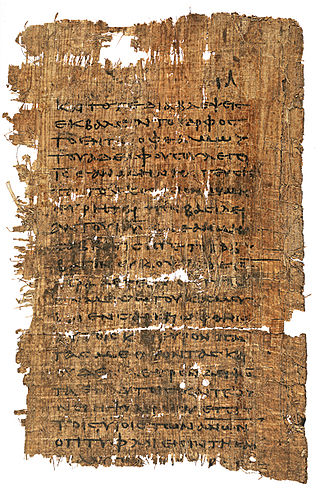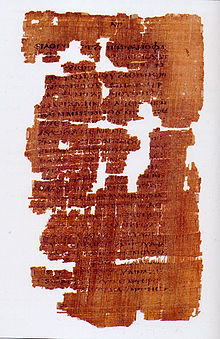
The Gospel of Thomas is an extra-canonical sayings gospel. It was discovered near Nag Hammadi, Egypt, in December 1945 among a group of books known as the Nag Hammadi library. Scholars speculate that the works were buried in response to a letter from Bishop Athanasius declaring a strict canon of Christian scripture. Scholars have proposed dates of composition as early as 60 AD and as late as 250 AD. Since its discovery, many scholars have seen it as evidence in support of the existence of a "Q source" which might have been very similar in its form as a collection of sayings of Jesus without any accounts of his deeds or his life and death, referred to as a sayings gospel.

The Nag Hammadi library is a collection of early Christian and Gnostic texts discovered near the Upper Egyptian town of Nag Hammadi in 1945.
The Berlin Codex, given the accession number Papyrus Berolinensis 8502, is a Coptic manuscript from the 5th century CE, unearthed in Akhmim, Egypt. In Cairo, in January 1896, Carl Reinhardt bought the codex, which had been recently discovered, wrapped in feathers, in a niche in a wall at a Christian burial site. It was a papyrus bound book, dating to early 5th century that was written in Sahidic dialect of Coptic, which was in common use in Egypt during that time.

The Apocryphon of John, also called the Secret Book of John or the Secret Revelation of John, is a 2nd-century Sethian Gnostic Christian pseudepigraphical text attributed to John the Apostle. It is one of the texts addressed by Irenaeus in his Against Heresies, placing its composition before 180 AD. It is presented as describing Jesus appearing and giving secret knowledge (gnosis) to his disciple John. The author describes it as having occurred after Jesus had "gone back to the place from which he came".

The Gospel of Judas is a non-canonical Gnostic gospel. The content consists of conversations between Jesus and Judas Iscariot. Given that it includes late 2nd-century theology, it is widely thought to have been composed in the 2nd century by Gnostic Christians. The only copy of it known to exist is a Coptic language text that has been carbon dated to 280 AD, plus or minus 60 years. It has been suggested that the text derives from an earlier manuscript in the Greek language. An English translation was first published in early 2006 by the National Geographic Society.
The Sethians were one of the main currents of Gnosticism during the 2nd and 3rd century AD, along with Valentinianism and Basilideanism. According to John D. Turner, it originated in the 2nd century AD as a fusion of two distinct Hellenistic Judaic philosophies and was influenced by Christianity and Middle Platonism. However, the exact origin of Sethianism is not properly understood.
Allogenes is a series of Gnostic texts. The main character in these texts is Allogenes, which translates as 'stranger,' 'foreigner,' or 'of another race.' The first text discovered was Allogenes as the third tractate in Codex XI of the Nag Hammadi library. The Coptic manuscript is a translation of a Greek original, likely written in Alexandria before 300 AD. In this text, containing Middle Platonic or Neoplatonic elements, Allogenes receives divine revelations.

The Gospel of the Truth is one of the Gnostic texts from the New Testament apocrypha found in the Nag Hammadi codices ("NHC"). It exists in two Coptic translations, a Subakhmimic rendition surviving almost in full in the first Nag Hammadi codex and a Sahidic in fragments in the twelfth codex.

Coptic binding or Coptic sewing comprises methods of bookbinding employed by early Christians in Egypt, the Copts, and used from as early as the 2nd century AD to the 11th century. The term is also used to describe modern bindings sewn in the same style.

The Bodmer Papyri are a group of twenty-two papyri discovered in Egypt in 1952. They are named after Martin Bodmer, who purchased them. The papyri contain segments from the Old and New Testaments, early Christian literature, Homer, and Menander. The oldest, P66 dates to c. 200 AD. Most of the papyri are kept at the Bodmer Library, in Cologny, Switzerland outside Geneva.

Marvin W. Meyer was a scholar of religion and a tenured professor at Chapman University, in Orange, California.
Birger A. Pearson is an American scholar and professor studying early Christianity and Gnosticism. He currently holds the positions of Professor Emeritus of Religious Studies at the University of California, Santa Barbara and Professor and Interim Director of the Religious Studies Program at the University of California, Berkeley.
April D. DeConick is the Isla Carroll and Percy E. Turner Professor of New Testament and Early Christianity at Rice University in Houston, Texas. She came to Rice University as a full professor in 2006, after receiving tenure at Illinois Wesleyan University in 2004. DeConick is the author of several books in the field of Early Christian Studies and is best known for her work on the Gospel of Thomas and ancient Gnosticism.
Stephen Emmel is a Coptologist and musician.

Papyrus Oxyrhynchus 1 is a papyrus fragment of the logia of Jesus written in Greek. It was among the first of the Oxyrhynchus Papyri discovered by Grenfell and Hunt. It was discovered on the second day of excavation, 12 January 1897, in the garbage mounds in the Egyptian town of Oxyrhynchus. The fragment is dated to the early half of the 3rd century. Grenfell and Hunt originally dated the fragment between 150 and 300, but "probably not written much later than the year 200." It was later discovered to be the oldest manuscript of the Gospel of Thomas.

Nag Hammadi Codex II is a papyrus codex with a collection of early Christian Gnostic texts in Coptic. The manuscript has survived in nearly perfect condition. The codex is dated to the 4th century. It is the only complete manuscript from antiquity with the text of the Gospel of Thomas.
British Library Or 4926 (1), known also as P. Lond. Copt. 522 (Crum), is a papyrus codex with a collection of early Christian Gnostic texts in Coptic. The manuscript has survived in a fragmentary condition. The codex is dated to the 4th century. Erroneously it is known also as British Library Or 4920 (1).
Nag Hammadi Codex XIII is a papyrus codex with a collection of early Christian Gnostic texts in Coptic. The manuscript is generally dated to the 4th century, though there is some debate regarding the original composition of the texts.
The Book of the Cock is a Geʽez narrative of the passion of Jesus. It was likely written in the fifth or sixth centuries and is based on an earlier version in Arabic or Greek. It has contemporary use among some Ethiopian Christians.









